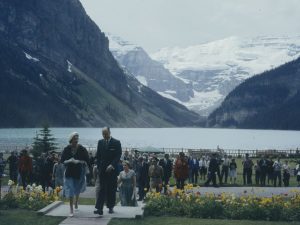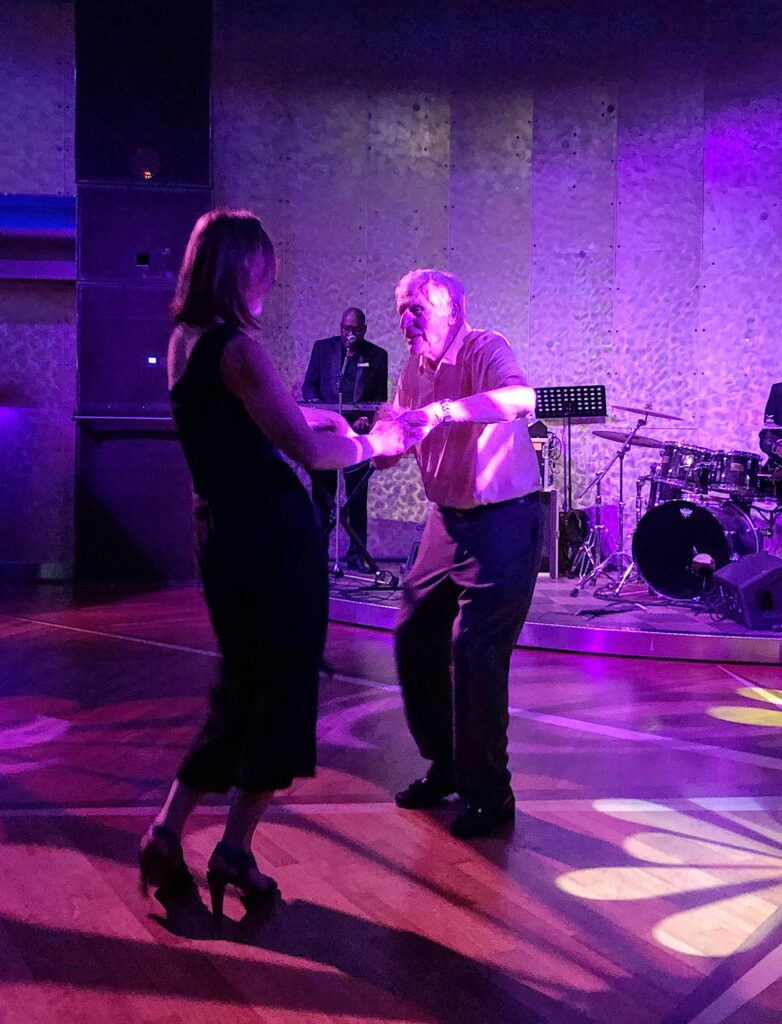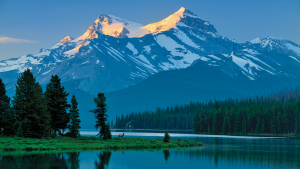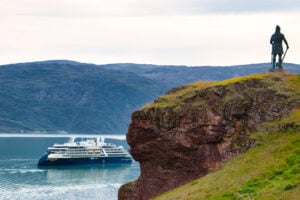
History
The Queen and Canada: A Platinum Jubilee timeline
Noteworthy occasions in a lifetime of service between Queen Elizabeth II and the Commonwealth country she has visited more than any other
- 1168 words
- 5 minutes
Travel
Rocking and rolling across the Atlantic on a voyage steeped in history aboard Cunard’s iconic ocean liner

Steve Melnikoff won’t dance with me.
It’s the second-last night of a seven-day transatlantic crossing from New York City to Southampton, England, aboard the iconic Cunard ocean liner Queen Mary 2. Melnikoff, a 102-year-old U.S. Army veteran of the Second World War, wants to dance the foxtrot, but I don’t know how. Fortunately for Steve, women dressed in their finest interpretations of Roaring ’20s attire are literally lining up for their chance to spin around the dancefloor with the famous Private Melnikoff, who over the course of the voyage has earned a reputation as a bit of a party animal.
Relegated to the sidelines of the Queens Room, Queen Mary 2’s soaring ballroom, I instead strike up a conversation with Harold Radish, also a Second World War vet. Watching couples circulate under twinkling chandeliers to big band standards by Glenn Miller and Cole Porter, Radish laments that, at 98, he no longer has the stamina to dance all night.
“Travelling through England during the war, every little town had a dance hall,” he says wistfully. My imagination transposes the scene onto the one before me: the officers in uniform, the women with their hair in pin curls and rolls, the orchestra swinging and sweating, and not for the first time this week, I feel as though I’ve stepped out of time. It’s not just that I’ve spent the last five days absorbing the stories of the two dozen or so veterans aboard, or that the ship’s clock has advanced by an hour a day, turning me into an unwitting night owl. It’s that the very idea of crossing the Atlantic by ship feels like a callback to a different era, one only superficially different from our own.

“It’s the people that give a ship a soul. A ship is just a piece of hardware without the people.”
It’s early Thursday afternoon, or as I’ve come to think of it, paraphrasing Douglas Adams, the long dark tea-time before another sumptuous five-course dinner. Queen Mary 2 is crossing the Mid-Atlantic Ridge, a continuous range of underwater volcanoes that bisects the Atlantic from the Arctic Ocean to the southern tip of Africa. Commodore Everette Hoard, historian of the Cunard “Queens,” is on stage in the Illuminations auditorium on Deck 3, giving a presentation about the art deco interior design of Queen Mary, Queen Mary 2’s predecessor and an icon of the golden age of transatlantic travel. Since 1967, she has been permanently moored at Long Beach, Calif., where she serves as a hotel and tourist attraction, but in the 1950s and early 60s, she was a floating playground for the rich and famous, ferrying the likes of Clark Gable, Elizabeth Taylor, Gary Cooper, Audrey Hepburn, Alfred Hitchcock and Doris Day between the U.S. and Europe. The Verandah Grill, a separate cabin-class dining room with capacity for 80, was the hotspot (and a particular favourite of Winston Churchill’s), says Hoard. “At midnight, they would serve their last diner, and then the chairs would be moved and there would be dancing until the Atlantic dawn.”

Similarly, the soul of Queen Mary 2 is most tangible after sundown, when we’re rocking and rolling with the waves and staggering around the dance floor to music from every era. This particular evening begins with drinks in the light-filled Commodore Club, whose windows overlook the bow and whose cocktail list is inspired by the men who have commanded Cunard’s fleet since the line was established in 1840. To keep my energy up for the night ahead, I opt for the “Chieftain of the Clan,” a shot of espresso mixed with cognac, peaty malt spirit, double cream and honey and served with a shortbread biscuit under a smoked glass dome alongside an actual pipe stuffed with chocolate shavings for garnish.
Then, it’s off to dinner in the Britannia Restaurant, where guests are encouraged to dress in “smart attire” for the evening meal and each dish, whether chicken, lamb, beef or fish, arrives cooked to perfection. By 9:30, the Queens Room is rocking to the hits of Elvis and the Beatles, played by the ship’s orchestra. At 11 — 8 according to my body clock — the party moves to G32, the night club tucked away aft of the Queens Room. Steve Melnikoff retires early instead of staying out til his customary 2 a.m., but not before requesting a Glenn Miller tune that brings a flurry of couples to the floor.
In between dances, I continue my weeklong quest to learn why my fellow passengers have opted to dedicate an entire week to a journey that takes around eight hours by plane. One man tells me he spent 40 years flying back and forth across the Atlantic for work; now retired, he can’t face the thought of another flight. Another man I speak to is travelling with his wife, three children and in-laws. They want to relax and make memories as a family after the uncertainty of the COVID-19 years, so they’re going to spend six weeks touring around the U.K. I find myself dancing with Katie, who is moving to Croatia and decided the start of her new life needed more pomp and fanfare than a glass of airport wine and an in-flight movie. At the bar, I meet John, a former commercial airline pilot from New Zealand who quit his job at the start of the pandemic and spent the next two years sailing around the world with his wife and two children. They sold their sailboat in Panama after his wife, suffering from seasickness, said enough was enough, and are making their slow way home to resume life on land.

Then there are the veterans, who are here under the auspices of the Greatest Generations Foundation, an American non-profit that returns combatants to the former battlegrounds where they served and ensures their stories are recorded and passed down. They are going to Normandy, France, with an urn containing the remains of 22 Second World War veterans. Every morning, they take to the Illuminations stage as part of Cunard’s Insights enrichment program to speak about their experiences in the war, their memories still vivid after 80 years. Steve Melnikoff is first, on the anniversary of D-Day, the second day of our sailing. He tells the packed auditorium about landing on Omaha Beach after the initial allied assault and making his way over the torn-up farm fields of Normandy, where every hedgerow concealed a German soldier or machine gun. He was shot in the neck while attempting to capture Saint-Lô and, after recovering in England, reported for duty in France again on Aug. 5, 1944. Within a few days, he says, his unit was so battered, the lieutenant put him in charge of a platoon of just 12 men.
At 102, Melnikoff still drives, still lives alone, still golfs two days a week. His advice for a long life is “don’t ever retire.”
“If you retire, you go downhill, so you have to do stuff, and you have to keep going.”
We meet Jim Blane, a Marine who fought at Iwo Jima, an island in the South Pacific that saw some of the fiercest fighting of the Pacific War. He suffered from survivor’s guilt and post-traumatic stress disorder for the rest of his life. Now 97, he attends a weekly support group that finally helped him name what he had been feeling.
James Harvey, a 99-year-old former Tuskegee Airman and part of the team that won the U.S. Air Force’s first-ever “Top Gun” competition, shares how he “had to fight two battles: the enemy and racism.” Harold Radish threw away his dog tags when he was captured by the Germans because they were stamped with an H, for Hebrew. “I still feel bad about that,” he says.
During these presentations, the silence is palpable; afterward, the entire audience is on their feet. The veterans become celebrities around the ship; guests thank them in the corridors and ask for autographs in the dining room. And, night after night, when the music starts and the dancers take the floor, the atmosphere is electric, elated. Grateful.



I’m reflecting on this when, on our last day at sea, I meet Everette Hoard for a drink at the Commodore Club. I ask him to expand on his remark about people being the soul of a ship. What makes it so?
“I think it’s the condensed amount of human life that goes through it,” he says.
There’s the excitement of an ocean crossing, the feeling of being connected to 180 years of history — Cunard ships brought hundreds of thousands of immigrants from Europe to the United States and Canada at the end of the 19th century — and the fun of making new friends on a ship that manages to feel at once intimate and expansive, with plenty of beautifully-appointed spaces that invite conversation.
But there’s something particular to our time, as well, Hoard says. When the original Queen Mary launched, the world was coming out of the Great Depression and people wanted to enjoy life, little knowing what lay ahead. It’s the same now, post-pandemic. There is relief and hope that, having weathered these past three years of global uncertainty, we can chart a better path forward.
“I for one am so gloriously happy to be afloat again,” Hoard says. “What a feeling of freedom it is out here!
“The peace that surpasses understanding is only found when land is 1,500 miles away on all sides,” he adds with the air of someone quoting Shakespeare or the Bible.
I look out across the water to the horizon, a view unchanged for seven days except by the weather and time of day.
“Are those your words?” I ask.
“No,” Hoard laughs, then clarifies: “I don’t remember who said them, so they’re mine.”
That night, the dancing goes on until 3. I have to disembark in Southampton at 8 a.m., but, with my circadian rhythm still locked in Eastern Time, I’m just not tired. I take the elevator up to Deck 13 and walk toward the bow, beneath glowing lights that spell out Queen Mary 2. I lean into the salt-scented wind off the port rail for the last time and smile at the first light of an Atlantic dawn.
Travel with us
Experience Cunard with the RCGS
Hear from Royal Canadian Geographical Society speakers on board select voyages with Cunard on Queen Elizabeth and Queen Mary 2
Are you passionate about Canadian geography?
You can support Canadian Geographic in 3 ways:

History
Noteworthy occasions in a lifetime of service between Queen Elizabeth II and the Commonwealth country she has visited more than any other

History
From noble mountains to local elementary schools, the Queen’s reign and the bonds she’s forged with Canadians are reflected across the map of Canada

Travel
Seeing iconic landscapes before they fade away may be accelerating their demise. Can we square the circle on making these trips sustainable?

Travel
Jill Doucette, founder and CEO of Synergy Enterprises, shares insights on new trends in the tourism industry and why there’s reason to be optimistic about a sustainable future for travel